|
|
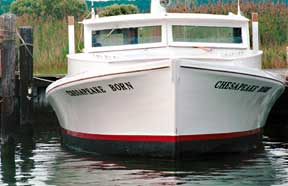 – But Just What Is She? – But Just What Is She?
Story and Photos by Scott Dine
Spend a couple of days around the docks of Chesapeake Bay, and you’re bound to hear her mentioned.
She’s a boat instantly recognizable, yet she’s a boat that no one in particular designed — though one just about everybody has built.
She’s a boat specifically suited to Bay watermen, yet she’s also a great pleasure vessel.
“Anybody seen that Hooper Island Drake Tail belonging to the Annapolis Maritime Museum?” I once asked marina workers on Spa Creek.
“Oh, yeah, she’s that Bay-built, but she’s not here today.”
Bay-built. She’s a boat as special to Chesapeake Bay as sloop is to sailing. So what is a Bay-built boat, besides a boat that is, well, built on the Bay? Will somebody please define Bay-built?
Defining Bay-Built is “mission impossible,” says Richard Dodds, curator of Calvert Maritime Museum in Solomons.
Bay-built may have “slipped” into the language, replacing another term, “bateau,” Dodds adds. Bateau, of course, is French for boat. Certainly a more elegant word than boat, but a boat is a boat. Or, as the French might say, a bateau is a bateau.
Then there’s that deadrise word. Some use the technical term “deadrise” to describe the Bay-built. Deadrise is also applied to the skipjack. By the dictionary, deadrise refers to the “angle with the horizon made by the outboard rise of the bottom of a vessel at the widest frame.” Here on the Chesapeake, deadrise refers to any vee-bottom hull. So deadrise doesn’t give us any help in understanding the Bay-built. All boats, regardless of bottom shape, have deadrise.
The Chesapeake deadrise has a vee-shaped bottom that grows progressively sharper as the vee moves from the stern. Near the bow, the vee becomes so sharp that it has almost the same angle as the topsides. The sharp vee forward makes for good entry to Chesapeake Bay’s choppy waters. The flatter stern smoothes out the ride.
Deadrise might also imply reincarnation. Sails on large vessels had been furling for most of the 19th century, replaced by steam- and then internal-combustion engines. By 1910, powered vessels were in great demand for fishing. And no wonder. Even a skipjack with its large sail area requires as many as five men to keep the boat moving and to harvest oysters. Without wind, the skipjack is useless. Russell Dive, of Tilghman Island, has heard stories of his grandfather using an oar-powered boat to pull his skipjack when the wind died.
A powered boat could be operated by one man, who could also work the harvest. It was the internal combustion engine that helped to kill the skipjack, reincarnated into what we know as the Bay-built. In the beginning, the internal-combustion engine was not too reliable, especially in the marine environment. And the law favored the skipjack. So it’s been a slow death for the skipjack. One hundred or so years after the Bay-built arrived, there are still a few working skipjacks. Very few. Dive operates the Catherine, which is one, he estimates, of about eight skipjacks harvesting shellfish.
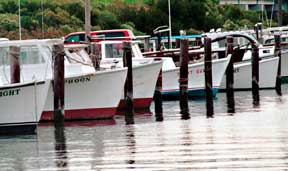 |
| Unlike today’s more common Bay-builts, above, the Hooper Island Draketail, below, has a swept-back stern that looks much like the tail of a cock mallard. |
|
|
Variations on the Theme
One of the best looking of the Bay-builts is the Hooper Island draketail, which came on the scene in the early 1920s. Draketail refers to the stern, which is swept back and looks much like the tail of a cock mallard. The rounded, swept-back stern was thought to be a help in following seas, preventing water from washing over transom into the cockpit.
A boat whose beam is about one sixth of its length, the draketail was considerably faster than most workboats, enabling the waterman to go farther for harvest. Some believe the draketail was the first workboat designed specifically for power. Before the draketail, many of the early powered workboats were skipjacks with a mast removed and an engine added.
When I caught up with the Annapolis Maritime Museum draketail, I saw that she was true to form: 36 feet, eight inches long, and six feet, eight inches in the beam. Built in 1925, she was never named. Peter Tasi of the Annapolis Maritime Museum believes she was built in the Cambridge area. The boat harvested oysters and crabs well into the 1980s. Donated to the museum by Reid Bandy, she still has most of her original hardware.
Ironically, it’s that beautiful draketail at its end that might have brought the boat to its end. The rudderpost was hard to get to for repair and maintenance, resulting in rotting around hull-post fittings. Tasi reports that when Bandy towed the draketail to his home in Mill Creek, he had to keep bilge pumps going so the boat wouldn’t sink.
Like a Jeep …
One cool fall morning, a Bay-built captain is at work on his boat. It’s the end of the crabbing season and just before the oyster harvest. He is repairing his deck, and sheets of marine plywood lie about the boat and the dockside. He measures the wood and makes the cuts with a power saw.
“She’s the same age as me,” he says, “35.”
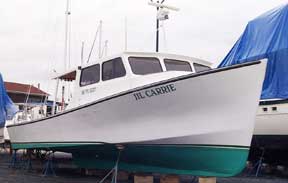 |
|
photo courtesy of Capt. Jim Brincefield
|
Much like a jeep, the Bay-built still looks like the working vehicle she was in her beginning. The jeep began in World War II and still looks like a jeep. Jeep genes are obvious even though Mercedes Benz has taken over Chrysler, which took over American Motors, which took over Willys, which originated the machine. Same with the Bay-built.
Every Bay-built has something of the same handsome, nautical look. Just as four-wheel drive on the jeep added to its range and versatility, the vee hull adds to the Bay-built’s seaworthiness. Designed for workspace, the boat has a large, open cockpit. Its low freeboard makes a shorter stretch for a waterman lifting in heavy crab pots or manipulating oyster tongs.
A pilothouse sits forward and usually contains not much more than a steering station for use in bad weather, possibly a head. A few have a bunk or two and a stove. Most pilothouses are not very long and get straight to the point: limited shelter when it is needed.
In other ways, the Bay-built has grown from a jeep into a two-and-a half-ton truck. Newer boats can be 50 feet long and quite beamy. Like trucks, there’s a Bay-built for nearly every job. Some are licensed for both the crab harvest and the oyster harvest. Some owners will harvest shellfish during the week and take sport fishermen out on weekend charter trips.
The sport fisherman is a bit more demanding than the Chesapeake waterman. He — and especially she — wants toilet facilities and possibly a place to warm coffee on a cold day. More accessories such as flush toilets, microwaves and electronic fish tracking gear are installed.
A larger boat means a larger engine. A very popular General Motors V-8 automobile engine for a smaller boat has been replaced by a Caterpillar diesel in the newer, larger vessels. Add size, add accessories, and the price increases. Add custom design at every turn for customers who like the style, though they don’t need it to make a living, and prices climb into the six-figures.
One Man’s Bay-Built
An aspiring waterman usually starts out purchasing a used boat from a waterman moving up or out. That’s how Captain Jim Brincefield, of Deale, began in 1992 when he purchased the Charlotte K to go into the charter fishing business.
Brincefield was bred to the water. He began fishing out of the Oakwood community on the South River. He fished from an outboard-powered skiff as a kid and from a Sunfish when he couldn’t get the outboard started. Brincefield has worked as a mate on Bay-builts, and he has been part of a skipjack crew. He has listened carefully to the sea tales of others while building his own knowledge of the Bay and the boat best suited to it.
He has packed all of that and himself into the 50-foot long, 16-foot wide Jil Carrie, for which he traded Charlotte K and a wad of cash.
Into the Jil Carrie, Brincefield has put a good deal of himself.
“You work on the boat, and you become part of it. At the same time, the boat becomes part of you,” he says.
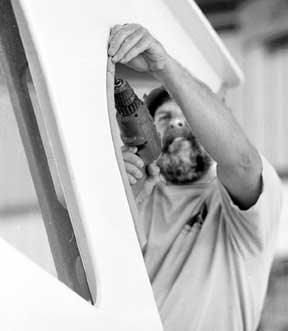 |
| Boatwright Joe Reid of Mast and Mallet builds his boats by hand, one at a time, from wood with a coat of fiberglass gel. |
Jil Carrie began life across the Bay in Crisfield, where her hull was laid. From the beginning, Brincefield helped in the construction. In Crisfield, he steamed frames for the sharp vee in the bow. When the hull was completed, Brincefield dropped in the diesel engines and brought her home to Deale. The pilothouse had no windows, no electronics, no finish work. She was put “on the hard” in Deale to be finished. There his friends, fellow captains and carpenters, pitched in.
Brincefield’s approach to boat design is to keep it simple. Jil Carrie’s pilothouse is basic, with a table portside seating three and another seat behind the steering station for two. Mounted above the wheel are navigation electronics, radar, throttles, and engine monitoring instruments. Below and forward of the pilothouse is a forecastle with a couple of benches that angle toward the bow, accented by the frames that Brincefield helped steam into shape. All told, Brincefield’s Jil Carrie is not only a Bay-built, she’s Brincefield built.
Climbing on an older boat built in Deltaville, Virginia, Brincefield explained his taste by comparison. Still, when Brincefield talks of other boats, he makes it plain that he’s talking about his personal preferences in a Bay-built. He makes certain that anyone within earshot understands his respect for other boats and the preferences of other watermen.
“Deltaville boats are different,” he said, leaning over the washboard, also known as the side deck, which he believes is too wide. “I want to be able to reach the water.”
He can’t on the Deltaville boat with her wide freeboard. He keeps his freeboard lower and has a minimal pilothouse because he wants less sail area, meaning that higher, more exposed boats catch the wind and are more difficult to navigate.
To get the larger boat with the length and breadth required for charter fishing means spending more money. Brincefield must meet a $2,500 payment on his boat each month. That means he’s got an $84-a-day bill to pay — and that’s before the diesel fuel is purchased or the hooks baited. That’s one reason why Brincefield and many other watermen keep their charter services going seven days a week, week in and week out.
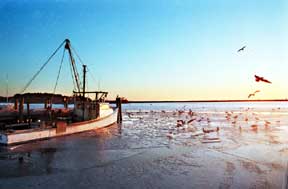 The More, the Merrier The More, the Merrier
All over Chesapeake Country, boatyards are turning out Bay-builts. None of these builders mass-produces boats. Most Bay-builts are built to order, customized by the buyer. A 40-foot Bay-built can cost in the hundreds of thousands of dollars, have finished bright work and teak trim throughout. Workboat owners could care less about finished bright work and deep-color hulls; white seems the color of choice among Bay captains.
Mathews Brothers in Cambridge has a line of seven Bay-builts ranging from 22 feet to 40 feet, all in fiberglass. Markley in Baltimore builds fiberglass hulls that are used by watermen, mainly for charter fishing. Plus, Markley produces boats for pleasure use.
In Mayo, Mast and Mallet produces cold-molded Bay-built pleasure-cruisers one at a time, in the 39- to 43-foot range. Joe Reid, who heads Mast and Mallet, is often seen hand-sanding and fitting teak trim. The ideal size for a Bay-built is about 43 feet with a 13-foot beam, says Reid. Reid builds a cold-molded wooden deadrise hull, then gives his hulls a fiberglass coating to seal the wood for longer life and easier maintenance.
On Rockhold Creek at Happy Harbor’s charter-fishing dock in Deale, Jil Carrie nestles alongside nearly a dozen other Bay-builts, boats with as much as 50 years service harvesting shellfish and fishing charters.
These older boats are wood, and wooden boats begin to leak around the chine plank, a plank, usually of oak, that extends from bow to stern and is attached inside the topside of the boat. The boat bottom begins at the chine plank. Fasteners are often galvanized nails, and when the galvanization washes away, rust and rot can develop. Reid says this is the weak part of the Bay-built hull. Replacing the chine plank is almost impossible.
So many old Bay-builts are getting new coats of fiberglass. One of those is Brincefield’s 40-foot-long, 13-foot-wide 1965 Abbots work boat, Diana W. Like Brincefield, nearly all watermen do their own maintenance — with a little help from their friends, who all know what a Bay-built is.
Copyright 2001
Bay Weekly
|